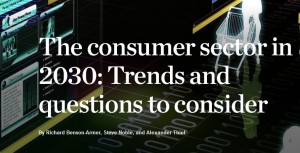In light of dramatic changes in the consumer landscape, how can retail and packaged-goods executives prepare for the future?
What can happen in 15 years? A look back at 2000 shows how much the world can change in just a decade and a half. Back then, about 30 percent of people in developing countries lived in extreme poverty, compared with less than 15 percent today. Only 12 percent of people owned a mobile phone; now, more than 60 percent do. Facebook, which today has almost 1.5 billion users, hadn’t launched yet. These and other developments have changed how consumers live, think, and shop—and the changes are only going to accelerate. What’s going on in the world economy is “no ordinary disruption,” as our colleagues have explained at length.
Disruptive forces can cause dramatic reversals. The retail and consumer-packaged-goods (CPG) sectors have seen such reversals in the past 15 years. In 2000, Kmart was the third-largest US retailer, with $36 billion in sales; by 2014, its annual revenues had declined by two-thirds. Over the same period, Amazon’s annual sales grew to $89 billion from about $2.8 billion. Alibaba, the market leader in China’s booming e-commerce business, was only a 15-year-old company when in 2014 it filed the largest IPO ever, valued at $25 billion. Anheuser-Busch was the world’s largest brewer in 2000; today, it no longer operates as an independent company, having been taken over by formerly smaller players.
The next 15 years, too, will bring their share of industry upheavals. We believe companies that want to be on top in 2030 must study emerging trends and begin preparing for them now. Certain trends will follow a pattern of predictable growth; others may take more surprising paths. In this article, we cite examples of both types of trends and some of their high-level implications for the consumer sector. We then recommend a set of actions that retail and CPG executives can take now to position themselves for success in the next decade and beyond.
…
More than five questions to consider
For most companies—regardless of geographic or category mix—the base-case trends will almost certainly result in financial pressures. In fact, our analysis indicates that close to 20 percent of companies in the consumer sector are already in financial distress today. Companies that are active primarily in mature, low-growth markets are particularly vulnerable. Spikes in input costs, even if partially offset by factors such as lower oil prices, could increase cost of goods sold and depress gross margins (in some categories, by as much as ten percentage points). Greater product complexity and rising labor costs could push up operating expenses by three to five percentage points. And investments in automation and digitization could increase depreciation on capital expenditures by two to three percentage points, even as they enable efficiency gains over time. Leaders would do well to consider the following five questions. Formulating thoughtful answers to these questions will help equip them for what lies ahead.
What makes us distinctive?
How can we engage consumers in an ongoing dialogue?
Are we paying enough attention to social media?
How can we involve consumers in brand innovation?
How can companies get away from the “stickiness” of historical resource allocation?
What strategic relationships should we seek out and nurture?
Have we digitized both our front and back end?
Have we adopted a ‘mobile first’ mind-set?
Are we advancing with analytics?
Answers in : www.mckinsey.com
Authors: Richard Benson-Armer is a director in McKinsey’s Stamford office, Steve Noble is a principal in the Minneapolis office, and Alexander Thiel is an associate principal in the Zurich office.
The authors wish to thank Navot Blits, Gregory Kelly, Sajal Kohli, James Naylor, Christina Zaybekian, and Stella Zhou for their contributions to this article.
